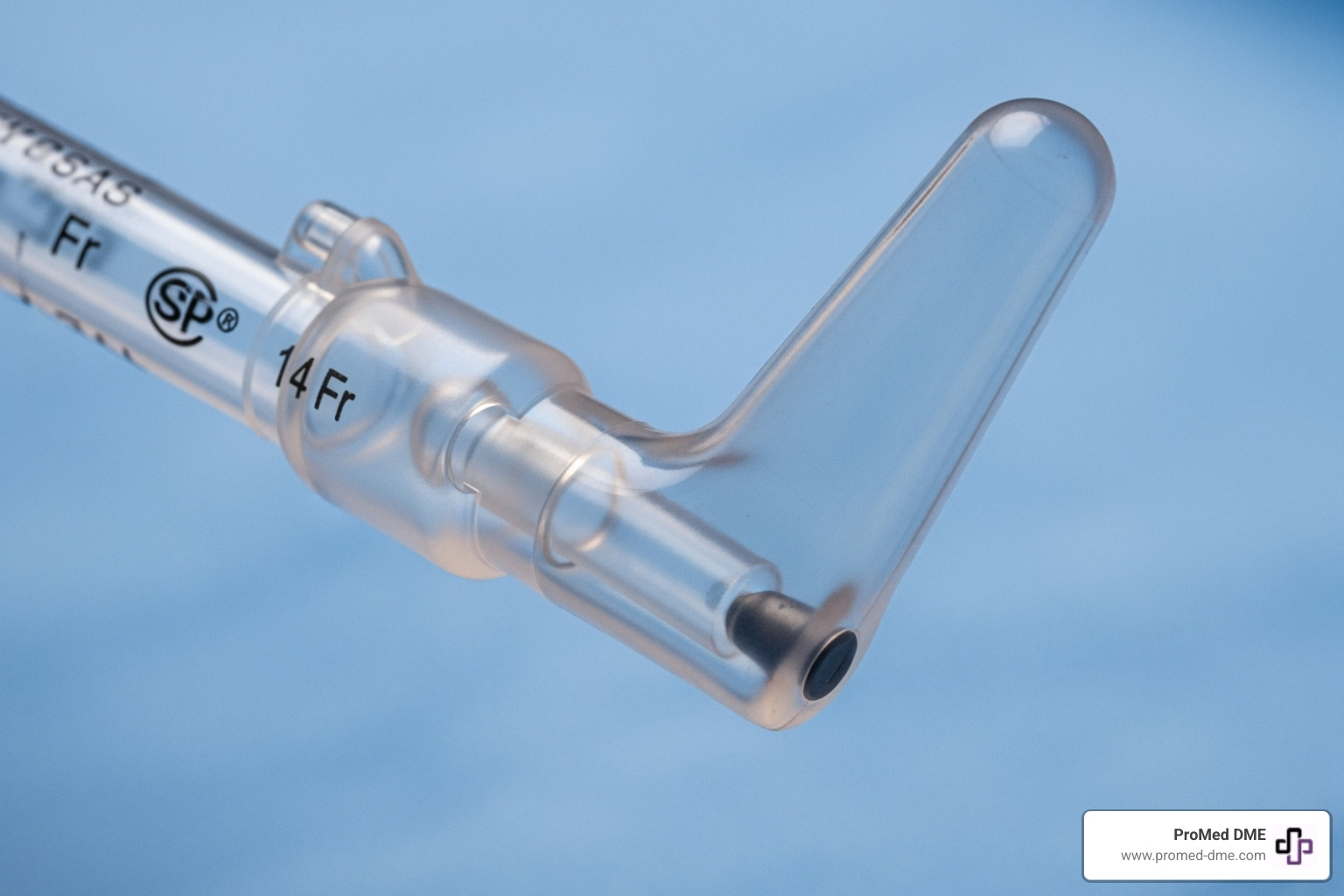Navigating Catheters: A Grown-Up's Handbook
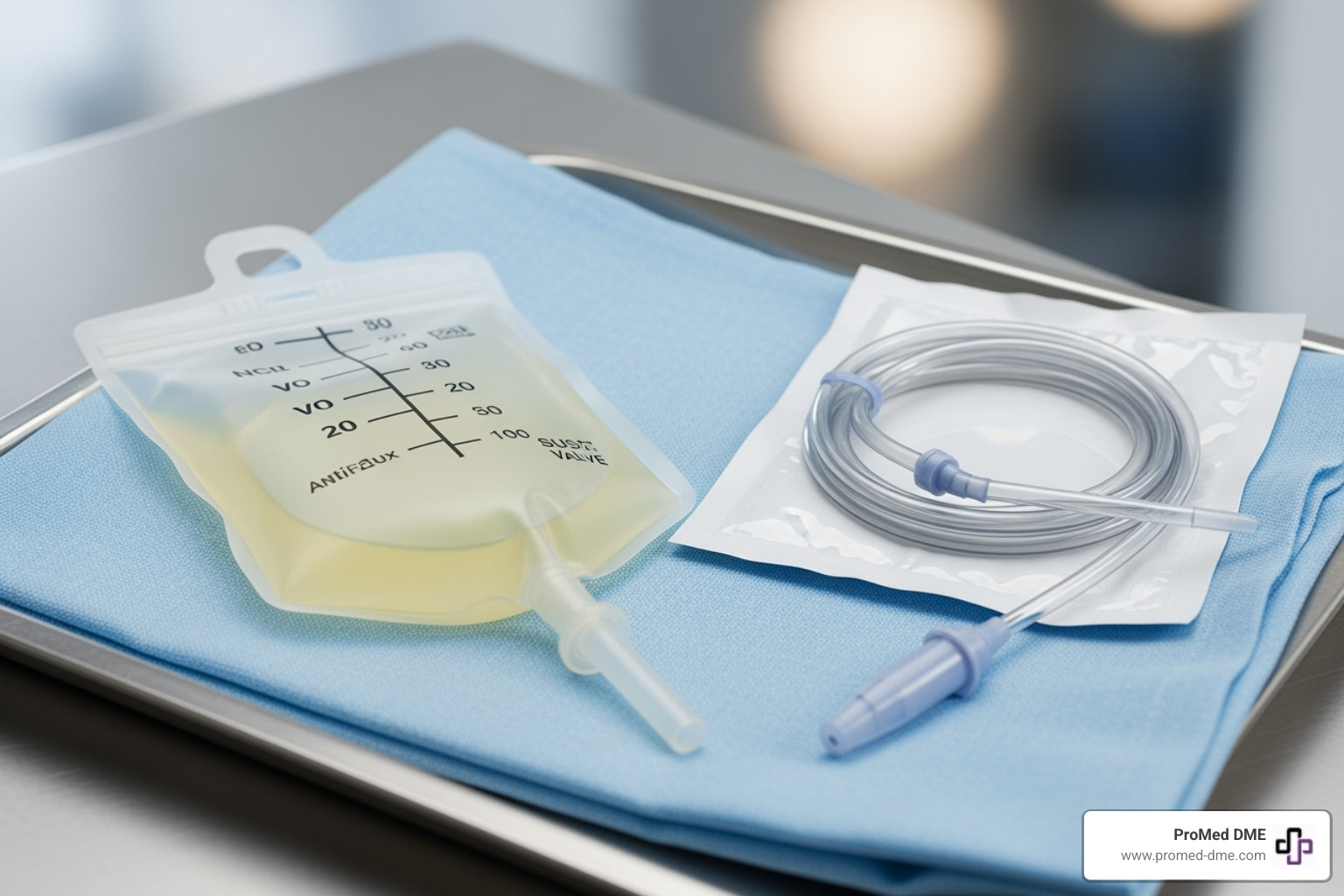
Understanding Your Catheter Options as an Adult
Catheter for adults are medical devices that help millions of people manage bladder problems with dignity and comfort. Whether you're dealing with urinary retention, incontinence, or recovering from surgery, the right catheter can make all the difference in your daily life.
Quick Answer: Adult Catheter Types
- Intermittent Catheters - Used 4-6 times daily, removed after each use
- Indwelling (Foley) Catheters - Stay in place for days/weeks with inflatable balloon
- External (Condom) Catheters - For men only, worn like a sheath outside the body
Common Sizes:
- Men: 14-16 French (Fr), most use 14 Fr
- Women: 10-12 Fr, most use 12 Fr
As one patient shared with their healthcare provider: "I wish I had known about the different options earlier - finding the right type changed everything for me."
You might need a catheter if you have nerve damage, an enlarged prostate, or problems emptying your bladder completely. The good news? Today's catheters are more comfortable and discreet than ever before.
The key is understanding which type fits your specific needs, lifestyle, and medical condition. Some people use catheters temporarily after surgery, while others rely on them long-term for chronic conditions.
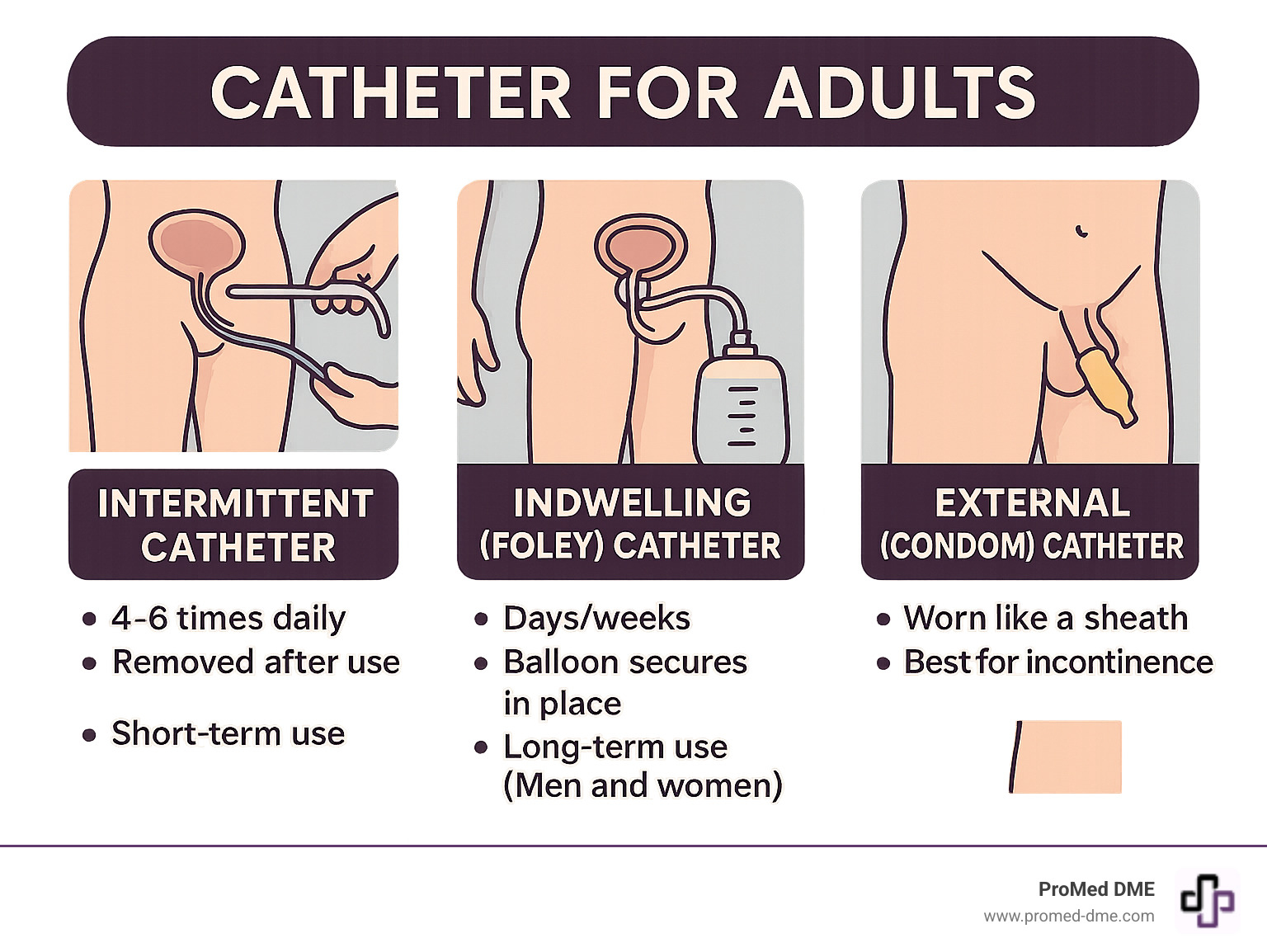
Catheter for adults terminology:
Introduction: What is a Urinary Catheter?
Think of a urinary catheter as a helpful bridge between your bladder and the outside world. It's a flexible tube that provides a pathway for urine to leave your body when your bladder can't do the job on its own.
A catheter for adults serves one main purpose: bladder drainage when natural urination is difficult or impossible. The tube is designed to be thin, soft, and comfortable.
Common reasons for needing a catheter include:
- Urinary retention: The bladder fills but won't empty completely.
- Urinary incontinence: The bladder empties involuntarily.
- Post-surgery care: To allow healing after procedures on the bladder or prostate.
- Nerve damage: From conditions like diabetes or spinal cord injuries that disrupt bladder control signals.
Using a catheter is crucial because trapped urine can back up into the kidneys, causing pressure and potentially serious damage. A catheter provides a clear exit route, preventing this complication. Today's catheters are more user-friendly than ever, allowing many people to maintain their independence and quality of life with proper care.
Decoding the Types of Urinary Catheters
Choosing the right catheter for adults can feel overwhelming, but it's like finding the right pair of shoes—what works for one person might not be ideal for another. Let's walk through the main types so you can understand which option might be the best fit.
Intermittent Catheters (Short-Term Use)
Intermittent catheters are for "in-and-out" use. You insert a straight catheter to empty your bladder and remove it immediately. This process, called self-catheterization, gives many users independence and control.
Users typically follow a schedule, emptying their bladder every 4-6 hours. This method is ideal for conditions like neurogenic bladder or an enlarged prostate.
We strongly recommend single-use catheters, which come sterilized. Scientific research on intermittent catheter use shows reusable catheters can harbor bacteria even after washing, increasing infection risk.
Modern intermittent catheters have features for convenience and safety. No-touch catheters have sleeves to prevent contamination. Pre-lubricated and hydrophilic catheters are designed for easier, more comfortable insertion.
Indwelling Catheters (Long-Term Use)
Indwelling catheters, or Foley catheters, are for people who need continuous bladder drainage. A small balloon at the tip is inflated inside the bladder to hold the catheter securely in place.
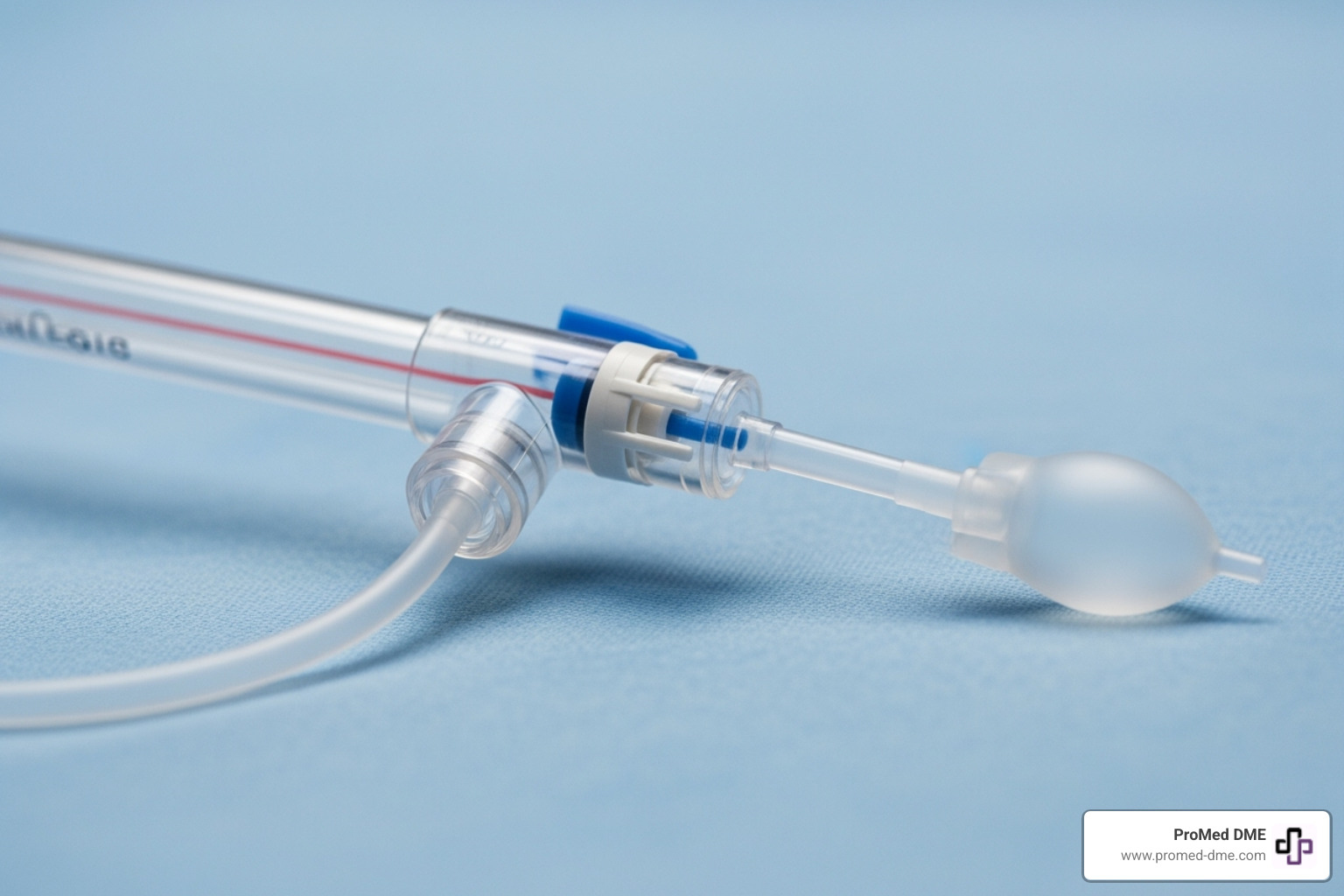
A urethral catheter is inserted through the urethra, while a suprapubic catheter enters the bladder through a small incision in the abdomen. Suprapubic catheters can be more comfortable for long-term use, especially for wheelchair users.
They provide continuous drainage into a collection bag (a smaller leg bag for day, a larger one for night). The changing schedule varies but can be up to three months, as determined by your healthcare provider. For detailed care instructions, see this Foley Catheter Care Guide.
External Catheters (Condom Catheters)
External catheters are designed for male anatomy only. These condom-like sheaths roll over the penis and connect to a drainage bag.
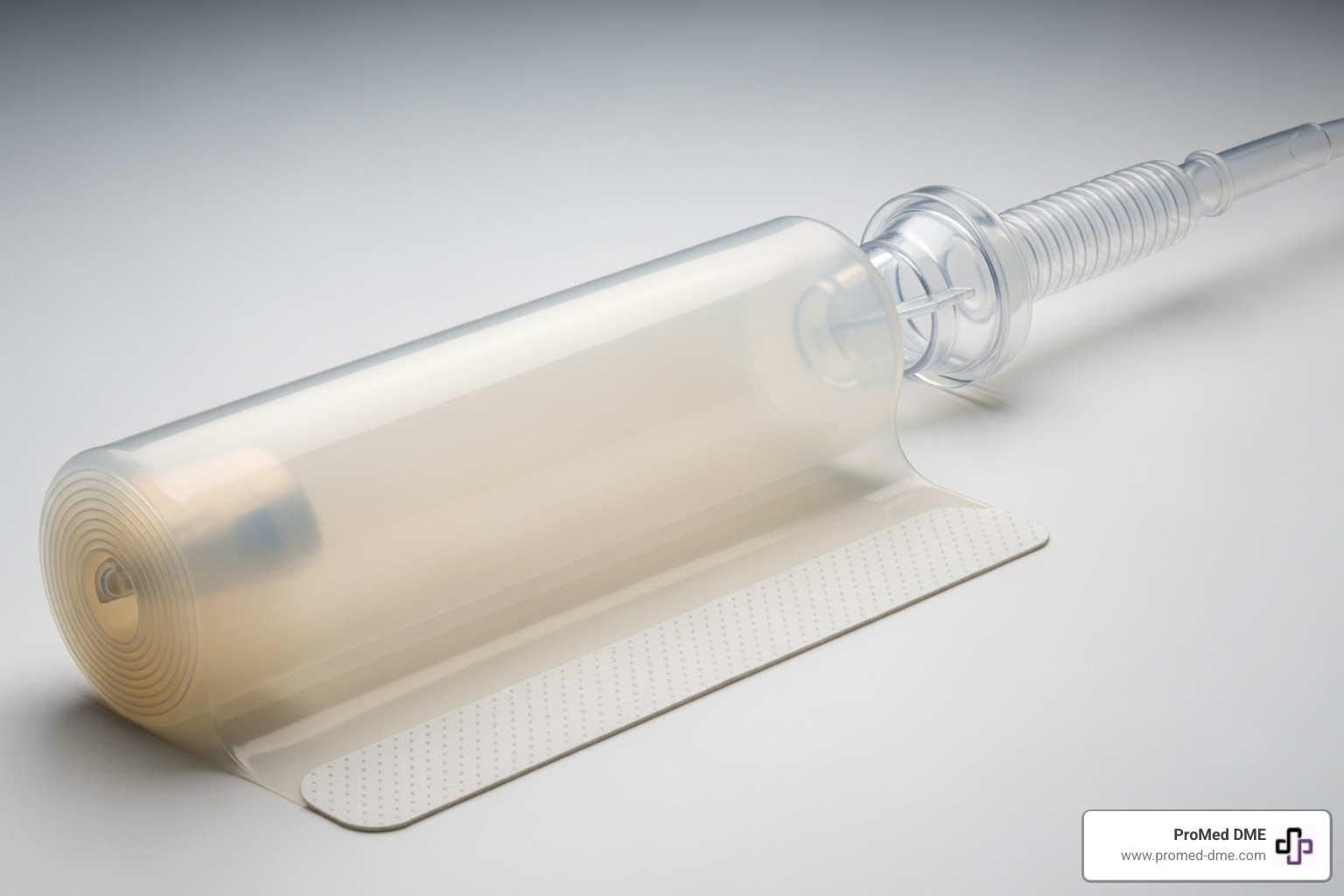
They offer a lower infection risk as they are non-invasive. However, they are not for urinary retention; they only manage incontinence (urine leakage) and do not help empty the bladder.
They typically require daily changes to prevent skin irritation. Proper application of the adhesives is key to preventing leaks and maintaining skin health.
Comparing Intermittent, Indwelling, and External Catheters
| Feature | Intermittent Catheters | Indwelling (Foley) Catheters | External (Condom) Catheters |
|---|---|---|---|
| Best for retention | Excellent - completely empties bladder | Good - continuous drainage | Not suitable - doesn't address retention |
| Best for incontinence | Not designed for this | Good - manages all urine | Excellent - catches leaked urine |
| Insertion method | Through urethra, removed immediately | Through urethra or abdomen, stays in place | Worn externally over penis |
| Duration of use | Multiple times daily, removed after each use | Days to months continuously | Changed daily |
| Infection risk level | Low (with proper single-use technique) | Higher (most common cause of healthcare UTIs) | Lowest (non-invasive) |
Getting the Right Fit: Understanding Catheter for Adults Sizing and Materials
Choosing the right catheter for adults is crucial, as the wrong size or material can cause discomfort and complications. Understanding the basics will help you make confident choices. Sizing is a balance: too large can cause trauma, while too small can lead to leaks. Your provider will help find the right fit, but knowing the system empowers you in your care.
How Catheter Diameter is Measured: The French Scale
Catheter diameter is measured using the French scale (abbreviated as Fr or Ch). The conversion is 1 Fr = 0.33 mm. You don't need to memorize this, just remember that a higher French number means a wider catheter.
Manufacturers use a color-coded system on the catheter funnels to make size identification easy. The size is also printed on the package.
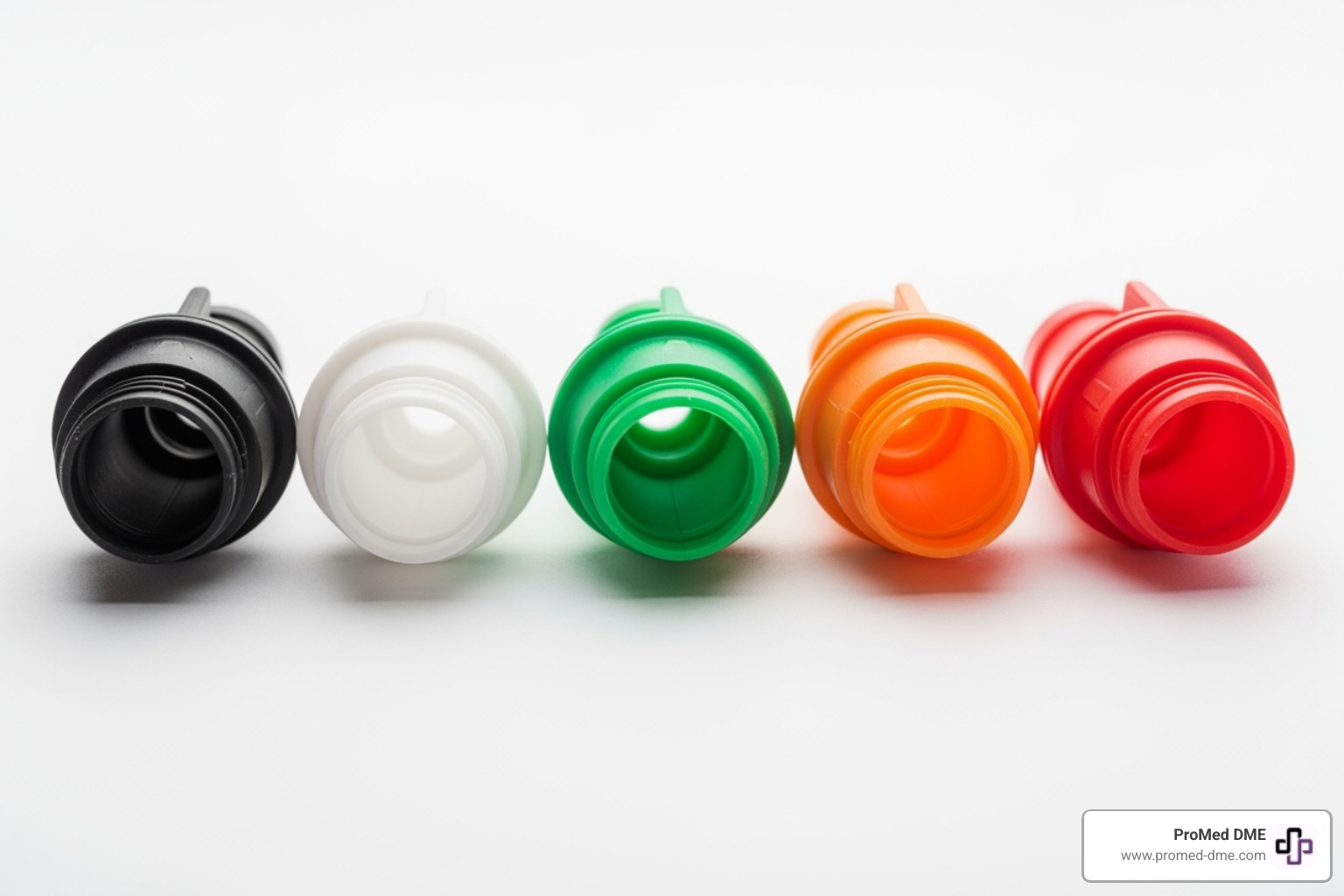
Standard colors include 10Fr (black), 12Fr (white), 14Fr (green), 16Fr (orange), and 18Fr (red). This system allows you to quickly identify your size by color.
Recommended Catheter Sizes for Adults
Healthcare professionals follow a key rule: use the smallest effective size. This CDC-recommended approach minimizes trauma to the urethra while ensuring proper drainage.
Generally, men use 14FR to 16FR catheters (14FR is most common), and women use 10FR to 12FR (12FR is most common). Your provider will determine the best size for your specific needs.
Larger sizes (18FR or more) may be needed to pass blood clots. A wider catheter (14FR-16FR) can also prevent blockages from debris or sediment in the urine.
Children need much smaller catheters, typically ranging from 6FR to 10FR, but that's a conversation for pediatric specialists.
Choosing the Right Catheter for Adults: Length and Material
Length is separate from diameter. Men typically need 15-18 inch catheters due to a longer urethra, while women use 7-10 inch catheters. The correct length prevents kinking and ensures it reaches the bladder.
The material your catheter is made from can make a huge difference in comfort and safety. Latex catheters are common but can cause allergic reactions; inform your provider if you have a latex allergy. Silicone catheters are a popular hypoallergenic alternative that is soft and flexible, offering greater comfort. PVC (plastic) catheters, often used for intermittent use, are firmer, which can make insertion easier for some.
The choice between firmness and flexibility is a personal preference. Discuss options with your healthcare team to find the best fit for you; some experimentation is normal.
Living with a Catheter: Care, Risks, and Complications
Living with a catheter for adults becomes manageable once you understand the basics of proper care. Think of it like brushing your teeth—it becomes second nature and is your best defense against complications. Good hygiene is the most important rule.
Daily Catheter Care and Hygiene
- Hand Washing: Always wash your hands with soap and water before and after handling your catheter or drainage bag.
- Cleaning the Insertion Site: At least twice daily, gently clean around the area where the catheter enters your body with soap and water, moving outward. Pat dry.
- Securing the Tube: Use a catheter strap to secure the tube to your leg, leaving a little slack to prevent tugging and ensure steady drainage.
- Emptying the Bag: Empty your drainage bag regularly—every 2-3 hours for leg bags and at least every 8 hours for larger bags. Don't let it get completely full.
- Cleaning the Bag: To clean a reusable bag, rinse with cool water, then use a solution of 1 part white vinegar to 3 parts water (or as directed by your provider). Air dry completely.
- Hydration and Diet: Stay hydrated to keep urine clear and flush out bacteria. A high-fiber diet prevents constipation, which can affect catheter function.
Recognizing and Preventing Catheter-Associated UTIs (CAUTIs)
Catheter-associated UTIs (CAUTIs) are the number one concern for catheter users and a leading cause of healthcare-associated infections. Contact your provider if you have UTI symptoms: fever, chills, cloudy or foul-smelling urine, burning, leakage around the catheter, blood in urine, or lower back pain.
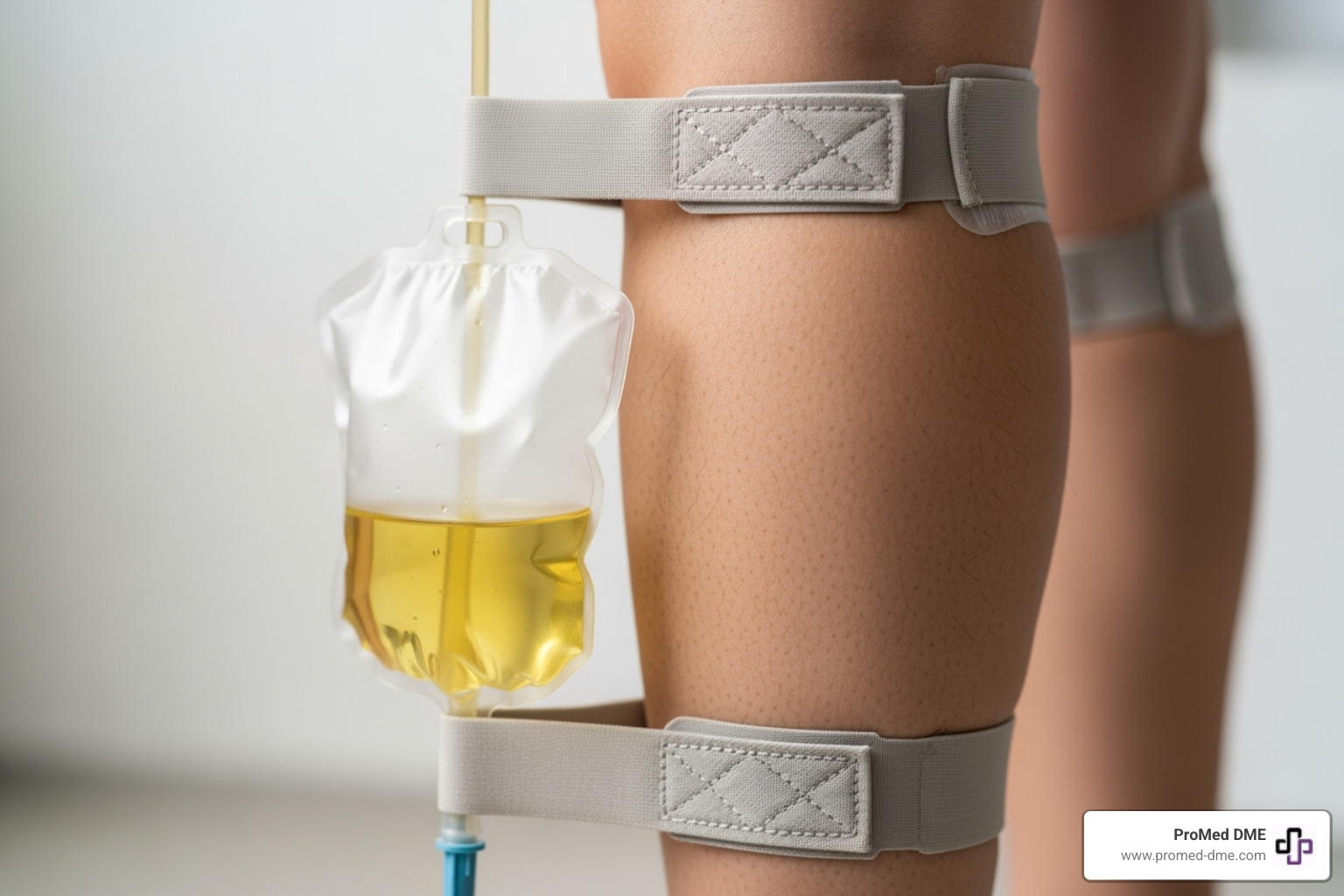
Prevention is the best medicine when it comes to CAUTIs. In addition to daily hygiene:
- Always keep your drainage bag below your bladder to prevent urine backflow.
- Ensure the tubing is free of kinks or twists for steady drainage.
- Use the smallest effective catheter size to minimize irritation.
Other Potential Risks and When to Call a Doctor
While UTIs are the main concern, other issues can arise. Bladder spasms feel like cramps and may be helped by a different catheter size or material. Leakage may indicate a blockage, spasms, or incorrect sizing. Small amounts of blood in your urine may be simple irritation, but always report it, especially if you see clots. Long-term risks include bladder stones, urethral injury, and blockages.
Know when to call for help. Contact your healthcare provider immediately if you have:
- Fever and chills
- Cloudy or foul-smelling urine
- Persistent leakage or abdominal pain
- Little to no urine output
- Significant blood in your urine
- Your catheter comes out unexpectedly
- Signs of an allergic reaction (rash, itching)
Frequently Asked Questions about Adult Catheters
It's completely normal to have questions about using a catheter for adults. Let's tackle some of the most common ones.
What is the difference between a straight catheter and a Foley catheter?
This question is about short-term vs. long-term solutions.
A straight catheter is an intermittent catheter for "in-and-out" use. You insert it to drain the bladder and remove it immediately. It's used multiple times a day for people who can't empty their bladder but don't need continuous drainage.
A Foley catheter is an indwelling catheter designed for long-term use. A small balloon is inflated in the bladder to hold it in place. It connects to a drainage bag and can remain for days or weeks, providing continuous drainage.
Is using a catheter for adults painful?
This is a common concern, but the good news is that catheter use is typically less painful than people fear.
During insertion, you may feel brief discomfort, but numbing gel is used to minimize this. Most people find it more uncomfortable than painful.
Once in place, a correctly sized catheter shouldn't hurt, though you might feel its presence. Bladder spasms (mild cramping) can occur but are manageable and usually improve over time.
Persistent pain is not normal. It could indicate an incorrect size or material. Talk to your provider, as a simple change can often resolve the issue. Removal is also very quick, though it may cause a moment of discomfort.
Can I live a normal life with a catheter?
Absolutely. While it may seem overwhelming initially, many people live full, active lives with a catheter.
Modern catheters are discreet, allowing you to continue work and social activities. You can maintain your normal bathing and showering routine. Travel is also possible with some planning—just pack extra supplies. While some adjustments may be needed, many physical activities are still possible. Sexual intimacy is also achievable; your healthcare provider can offer specific guidance based on your catheter type. Open communication with your provider is key to tailoring a management plan that fits your lifestyle.
Conclusion: Taking the Next Step with Confidence
Navigating catheters for adults can be daunting, but you're now equipped with the knowledge to proceed confidently. You've learned about the three main types: intermittent, indwelling (Foley), and external (condom) catheters.
You also understand sizing (the French scale), materials (silicone, latex, PVC), and the importance of daily care to prevent complications like infections.
Every person's needs are different. What works for one person may not be the right fit for you. That's why your healthcare provider's guidance is so valuable—they can help you find the perfect combination of type, size, and material for your specific situation.
Living with a catheter doesn't mean giving up the activities you love. With the right support and supplies, you can continue working, traveling, and enjoying life.
At ProMed DME, we know managing your health is about more than just supplies. Based in Stuart, Florida, we serve customers across the U.S. with exceptional customer service. When you call, you connect with our dedicated team, including a nurse on staff who understands your needs.
We believe in affordable care. We offer free shipping and work with most insurance plans to minimize your out-of-pocket costs, reducing financial stress.
For reliable urology supplies and the kind of personal support that makes all the difference, you can find more information and assistance here: More info about urology supplies. We're here to help you take the next step with confidence, knowing you have a trusted partner in your corner.
Related Resources & Articles
Stay informed with our informative blog posts.
Discover the ProMed Advantage
& Try Our Products
We offer free shipping and legendary customer service to ensure you receive the
best DME products for your needs.


